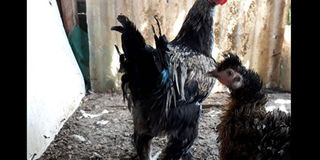Diary of a poultry farmer: Pains and joys of feathered shanks

Chicken with feathered shanks. As such, these birds' feathered-feet easily pick up dirt, mud and droppings and may require regular cleaning, they are also susceptible to infestation with scaly leg mites. PHOTO | COURTESY
What you need to know:
- A shank is the bottom part of a chicken’s leg above the foot and below the hock. The spur (the chicken’s protective weapon) grows out of the shank.
- From my reading, the trait of feathered feet in chicken breeds originated in Asia. Later, selective breeding allowed this trait to evolve into other fowls.
- Whereas the beard is found under the chin, the muffs are found on the side of the face. What I’ve observed is that in most cases, the beards and muffs will occur together.
- However, when the F1 generation is crossed, the F2 generation contains chickens with feathered shanks to unfeathered shanks in a ratio of 15 to one.
To start us off, here’s a giddy quiz to jog your memory.
According to common mythology among ethnic groups in Kenya, which one of the following breeds of indigenous chickens is believed to keep debtors and visitors at bay: a) Frizzles; b) Naked necks; c) Dwarfed; d) Feathered shanks.
I’ll get to the answer in a short while.
If you’re a fan of feathered chickens – crests, beards, tufts or muffs – you’ll probably feel at home with a feathered shank as a pet. But not so quick!
You see, the first time I set my eyes on a feathered shank (feet), I thought to myself, “Any day on my carpet except on a rainy day when it’s all mud and slime in the backyard.”
You see, extra-feathering especially on the shanks of chickens may be charming at first, but it comes with extra responsibility.
Here’s some basic anatomy. A shank is the bottom part of a chicken’s leg above the foot and below the hock. The spur (the chicken’s protective weapon) grows out of the shank.
In fact, some varieties of chickens have feathered shanks (legs), but others do not. Common chicken breeds with feathers on their legs include Cochin, Brahma, Sultan, and American Silkies.
I read somewhere that the extent of the shank and foot-feathering will vary between chicken breeds. As a matter of fact, breeds such as the Booted Bantam have their entire legs and feet covered with feathers.
From my reading, the trait of feathered feet in chicken breeds originated in Asia. Later, selective breeding allowed this trait to evolve into other fowls.
As I mentioned, having these birds in your backyard is not always a bed of roses. Like other birds, they enjoy wandering through the garden eating worms, insects and grass.
CHALLENGES THESE BIRDS FACE
As such, their feathered-feet easily pick up dirt, mud and droppings and may require regular cleaning. They are also more susceptible to infestation with scaly leg mites.
Another thing I’ve observed is that other birds tend to pick on the feathers of these birds and sometimes this can lead to injuries.
As you’d guess, their thick feathered feet allow them to thrive better in cold environments.
If you’re thinking like I did at some point that “this extra- feathering is not my thing,” you have the choice of crested, bearded and muffed chicken breeds. Crests are chickens with extra-feathering found on their head.
On the other hand, beards and muffs are the additional feathers that are grouped on the head area of particular chicken breeds. Whereas the beard is found under the chin, the muffs are found on the side of the face. What I’ve observed is that in most cases, the beards and muffs will occur together.
I know you’re eager to know how to breed a feathered shank but remember you can’t quote me on this because I couldn’t get an expert poultry breeder to verify.
I read somewhere that if you cross a feathered shank with an unfeathered shank, all the shanks of the F1 generation will be feathered.
However, when the F1 generation is crossed, the F2 generation contains chickens with feathered shanks to unfeathered shanks in a ratio of 15 to one.
For now, until my feathered cock matures, you’ll have to wait a little longer.
Here’s the answer to my quiz. From my enquiries, the Luhya, Kisii and Kamba ethnic communities believe that if you slaughter a frizzled chicken for your landlord or lady, they’ll never recall that you have unpaid rent arrears.
There you go!





